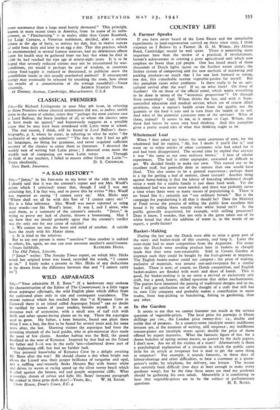WILD ASPARAGUS
Sia,—" Your admirable H. E. Bates" (if a landowner may endorse the characterisation of the Editor of The Countryman) is a little vague about asparagus officinalis, the wild English plant which differs from the cultivated plant only in size and consequent succulence. The remote rumour which has reached him that "at Kynance Cove in Cornwall there is an island called Asparagus Island" can no doubt be verified by scores of your readers, besides myself. It is an immense rock of serpentine, with a small area of turf rich with thrift and other spume-loving plants on its top. There the asparagus used to grow. My father, a keen botanist, found one plant there when I was a boy, the first to be found for several years and, for some years after, the last. Showing visitors the asparagus had been the crowning triumph of the local guides, who in pre-motorcar days made the most of few clients. Another habitat was the Brill, the grand headland to the west of Kynance. Inspired by that find on the Island my father and I—it was in the early '9os—clambered down part of that frightening cliff, but had no further luck.
May personal knowledge of Kynance Cove be a delight awaiting Mr. Bates after the war! He should choose a day when bright sun allows the Lizard seas their proper brilliance of turquoise and opal, and a ruffling sou'-westerly flecks Mounts Bay with foamy white and drives its waves at racing speed up the silver tawny beach which is piled against the brown, red and purple serpentine cliffs. What a nostalgic dream of colour and light Mr. Bates' innocent paragraph






























 Previous page
Previous page